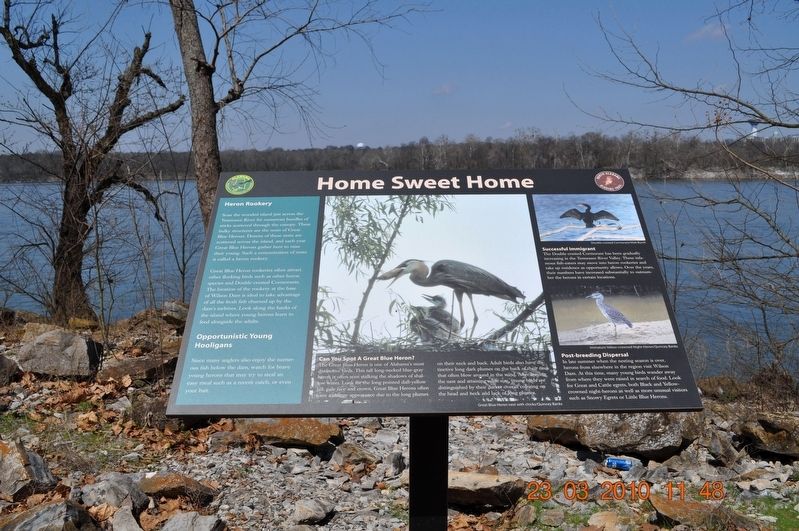Home Sweet Home
Heron Rookery
Great Blue Heron rookeries often attract other flocking birds such as other heron species and Double-crested Cormorants.
The location of the rookery at the base of Wilson Dam is ideal to take advantage of all the fresh fish churned up by the dam's turbines. Look along the banks of the island where young herons learn to feed alongside the adults
Opportunistic Young Hooligans
Since many anglers also enjoy the numerous fish below the dam, watch for brave young herons that may try to seal an easy meal such as a recent catch, or even your bait.
Can you spot a Great Blue Heron?
The Great Blue Heron is one of Alabama's most distinctive birds. This tall long-necked blue-gray heron is often seen stalking the shadows of shallow water. Look for the long pointed dull-yellow bill, pale face and crown. Great Blue Herons often have a shaggy appearance due to the long plumes on their neck and back. Adult birds also have distinctive long dark plumes on the back of their
Successful Immigrant
The Double-crested Cormorant has been gradually increasing in the Tennessee River Valley. These infamous fish-eaters may move into heron rookeries and take up residence as opportunity allows. Over the years, their numbers have increased substantially to outnumber the herons in certain locations.
Post-breeding Dispersal
In late summer when the nesting season is over, herons from elsewhere in the region visit Wilson Dam. At this time, many young birds wander away from where they were raised in search of food. Look for Great and Cattle egrets, both Black and Yellow-crowned night-herons as well as more unusual visitors such as Snowy Egrets or Little Blue Herons.
Topics. This historical marker is listed in these topic lists: Animals • Environment.
Location. 34° 47.588′ N, 87° 37.916′ W. Marker is in Muscle Shoals, Alabama, in Colbert County. Marker can be reached from Reservation Road. This marker is located at TVA's Wilson Dam near the boat ramp and Rockpile Park. Touch for map. Marker is in this post office area: Muscle Shoals AL 35661, United States of America. Touch for directions.
Other nearby markers. At least 8 other markers are within walking distance
Also see . . .
1. Great Blue Heron. Habitat Look for Great Blue Herons in saltwater and freshwater habitats, from open coasts, marshes, sloughs, riverbanks, and lakes to backyard goldfish ponds. They also forage in grasslands and agricultural fields. Breeding birds gather in colonies or “heronries” to build stick nests high off the ground. (Submitted on July 27, 2017, by Sandra Hughes Tidwell of Killen, Alabama, USA.)
2. Double-crested Cormorant. Habitat Double-crested Cormorants are the most widespread cormorant in North America, and the one most frequently seen in freshwater. They breed on the coast as well as on large inland lakes. They form colonies of stick nests built high in trees on islands or in patches of flooded timber. (Submitted on July 27, 2017, by Sandra Hughes Tidwell of Killen, Alabama, USA.)
3. Yellow-crowned Night-Heron. Habitat They are most common in coastal wetlands barrier islands, saltmarshes, drainage ditches, and mangroves; they also occur inland along bottomland forests, swamps, and sometimes wet lawns or fields. (Submitted on July 27, 2017, by Sandra Hughes Tidwell of Killen, Alabama, USA.)
Credits. This page was last revised on August 3, 2017. It was originally submitted on July 27, 2017, by Sandra Hughes Tidwell of Killen, Alabama, USA. This page has been viewed 288 times since then and 18 times this year. Photo 1. submitted on July 27, 2017, by Sandra Hughes Tidwell of Killen, Alabama, USA. • Bill Pfingsten was the editor who published this page.
Editor’s want-list for this marker. A wide shot of the marker and its surroundings. • Can you help?
